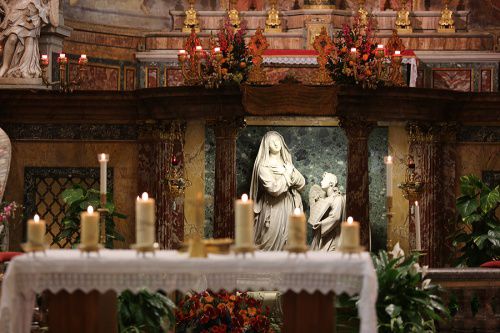Although she's not as well known outside of Rome, Saint Francesca Romana has been lauded as a woman whose charity and service to the poor rival those of the modern-day, soon-to-be saint Mother Teresa.
Saint Francesca Romana, also known as Saint Frances of Rome, is “a saint loved because she was, in 1400, like we consider Mother Teresa of Calcutta today,” Fr. Teodoro Muti told CNA March 9.
“She was the saint of the poor and of the needy,” he said, noting that although she belonged to a rich and noble family, the saint spent much of her free time in the hospital caring for the sick.
And she didn't just care for the infirmities of the body, “but also to the infirmities of the spirit; she united the two things: the care of the body and of the spirit.”
Fr. Muti is a monk with the order of Our Lady of Mount Olivet, also called the Olivetans, who operate the Basilica of Forno where St. Francesca Romana’s remains have been buried since her death in 1440.
Frequently called the “most Roman of the saints,” Francesca is the co-patron of the city. A wife and mother, she also became a member of a lay order she founded called the Oblates of Mary.
The religious house Francesca founded is still present in Rome today. While the basilica containing her remains is open all year, the house is only open to the public once a year on her March 9 feast, allowing visitors to see two rooms filled with historic frescoes, one of which was her former cell.
During her life Francesca had an Olivetan monk as a confessor, which set the foundation for her order’s close relationship with the Olivetans today.
Born in Rome in 1384 to a noble family, Francesca was determined to dedicate her life to God as a nun at the age of 11. However, her father forbid it and arranged for her to be married to a young man named Lorenzo, who was also from a wealthy family.
Though she initially refused the marriage, Francesca eventually agreed after speaking with her confessor, who urged her to pursue the will of God rather than her own.
She married Lorenzo at the age of 13, but soon became ill due to the stress of her new, lavish lifestyle. Preferring to do penance instead of entertaining and holding banquets, Francesca was on the verge of death when she decided to submit herself to the will of God once again.
After an immediate recovery, Francesca eventually became close with her sister-in-law Vannozza, who also desired to dedicate her life to God. However, despite their wish to consecrate themselves to the Lord, the two decided that their obligations to the family came first.
Together they assumed all the responsibilities of their rank, but also committed to a strong spiritual life, attending Mass together, visiting prisons and serving in hospitals.
Shortly after Francesca’s three children were born, a flood brought disease and famine to Rome. In response to the desperation of the city, Francesca and Vannezza went out together and distributed corn, wine, oil and clothing to the poor.
When Francesca’s father-in-law attempted to stop them by selling all of their extra supplies, the two women went out to beg instead in order to give to the poor. Francesca even combed through the straw in their loft to find extra kernels of corn. After she left, her husband arrived and found the previously empty granary completely full.
When war broke out in Rome in the late 1300s, Francesca’s husband Lorenzo was seriously wounded, their house destroyed and their eldest son kidnapped. Her two younger children died shortly after with the outbreak of the plague.
However, instead of despairing, Francesca turned their ruined house into a makeshift hospital and a shelter for the homeless.
In return for taking the lives of her children, God gave Francesca the special grace of being able to see her guardian angel, who served as her companion and spiritual guide.
Eventually both Lorenzo and their eldest son had returned home. Once she nursed her husband back to health and with his blessing, Frances founded a lay order of women called the Oblates of Mary, who share the Benedictine spirituality.
Although the women still lived in the world, they pledged themselves to God and to the service of the poor.
When Lorenzo died, Francesca went to live in a house for the widowed members of the community. She served as superior for four years until her death in 1440.
Fr. Muti said Francesca is widely considered “the saint of mercy” in Rome, because “she practiced all of the spiritual and corporal works of mercy.”
The priest noted that while there are many saints buried in Rome, not many of them are locals. Because of this she is considered “the saint of the city,” and devotion to her is so strong that even today many young girls are named after her.
Each year thousands of pilgrims and locals leave letters, cards and photos at her tomb in the Basilica of Forno, which consists of a glass case containing her skeleton, with a veil on her head.
Fr. Muti said that in addition to celebrating Mass and offering various prayers throughout the day, Francesca’s feast is also marked with the blessing of cars near the coliseum.
The blessing is rooted in the fact that Francesca’s guardian angel would accompany her on her nightly rounds in the city.
Although it was dangerous at the time, “the angel always protected her from any harm,” Fr. Muti said, explaining that it is for this reason Pope Pius XI proclaimed her patron of motorists, which prompted what has become the annual Roman tradition of blessing cars on her feast day.

